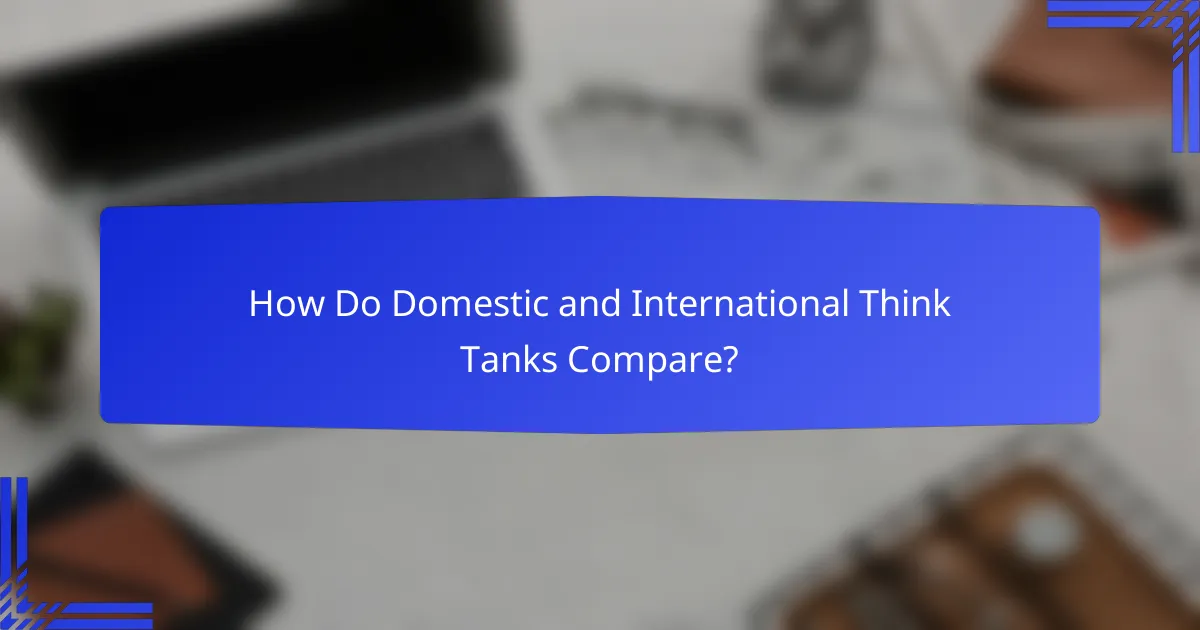Think tanks play a crucial role in shaping geopolitical trends, with domestic and international organizations influencing policy and public opinion in distinct ways. Domestic think tanks focus on national issues, providing insights that guide local decision-making, while international think tanks address global challenges, offering research that informs policies across borders. Understanding the differences in their focus and reach is essential to grasp their respective impacts on the geopolitical landscape.

How Do Domestic Think Tanks Influence Geopolitical Trends?
Domestic think tanks significantly shape geopolitical trends by providing policy insights, influencing public opinion, and collaborating with government entities. Their research and recommendations often guide decision-making processes that affect national and international relations.
Policy recommendations
Domestic think tanks develop policy recommendations that address pressing geopolitical issues. These recommendations are often based on extensive research and analysis, aiming to inform lawmakers and stakeholders about potential strategies. For example, a think tank might propose new trade policies to enhance economic relations with a specific country.
Effective policy recommendations typically consider both short-term impacts and long-term consequences, helping to navigate complex geopolitical landscapes. Think tanks may also evaluate existing policies, suggesting modifications to better align with current global dynamics.
Public opinion shaping
Domestic think tanks play a crucial role in shaping public opinion regarding foreign affairs and national security. Through media outreach, public events, and social media engagement, they disseminate their findings and perspectives to a broader audience. This can lead to increased public awareness and support for specific geopolitical strategies.
By framing issues in a particular light, think tanks can influence how citizens perceive international relations. For instance, a think tank might highlight the benefits of diplomatic engagement with a rival nation, thereby swaying public sentiment toward more favorable policies.
Research publications
Research publications from domestic think tanks provide valuable insights into geopolitical trends and challenges. These publications often include in-depth analyses, case studies, and forecasts that inform both policymakers and the public. They serve as a critical resource for understanding complex international issues.
Many think tanks publish reports, articles, and policy briefs that are accessible online, allowing for widespread dissemination of their research. This transparency helps foster informed discussions about national interests and global affairs.
Collaborations with government
Collaborations between domestic think tanks and government agencies enhance the development of informed policies. Think tanks often work directly with policymakers to provide expertise and data-driven insights that shape legislative agendas. This partnership can lead to more effective and responsive governance.
Such collaborations may involve advisory roles, joint research projects, or participation in governmental task forces. By leveraging the expertise of think tanks, governments can better address geopolitical challenges and adapt to changing international landscapes.

What Impact Do International Think Tanks Have on Global Policies?
International think tanks significantly shape global policies by providing research, analysis, and recommendations that inform decision-makers. Their influence extends across various sectors, including economics, security, and environmental issues, often guiding the agendas of governments and organizations worldwide.
Global research initiatives
International think tanks engage in extensive research initiatives that address pressing global challenges. These initiatives often focus on topics like climate change, trade relations, and security threats, producing reports that synthesize data and offer actionable insights. For example, a think tank might publish a comprehensive study on the economic impacts of climate policies, influencing both national and international strategies.
Collaboration with universities and research institutions enhances the credibility and reach of these initiatives. By pooling resources and expertise, think tanks can tackle complex issues more effectively, leading to well-rounded policy recommendations that consider diverse perspectives.
Cross-border collaborations
Cross-border collaborations among international think tanks facilitate the exchange of ideas and best practices. These partnerships often involve joint projects, conferences, and workshops that bring together experts from different countries to discuss shared challenges. Such collaborations can amplify the impact of research findings, making them more relevant to a global audience.
For instance, a coalition of think tanks from various regions may work together to address cybersecurity threats, sharing insights and strategies that reflect the unique vulnerabilities of their respective countries. This collective approach fosters a more comprehensive understanding of global issues and encourages coordinated responses.
Influence on international organizations
International think tanks play a crucial role in shaping the policies of international organizations such as the United Nations and the World Bank. By providing evidence-based research and policy recommendations, they help these organizations formulate strategies that address global challenges effectively. Think tanks often participate in discussions and forums, ensuring that their insights reach key decision-makers.
Moreover, their influence can be seen in the development of international agreements and frameworks. For example, think tanks may contribute to negotiations on climate accords by offering data-driven analyses that highlight the economic and environmental benefits of proposed measures, thereby swaying the opinions of negotiators and member states.

How Do Domestic and International Think Tanks Compare?
Domestic and international think tanks differ significantly in their focus, funding, and geographic reach. Understanding these differences helps clarify their respective influences on geopolitical trends.
Focus areas
Domestic think tanks primarily concentrate on national issues, such as economic policy, healthcare, and education reform. They aim to influence local legislation and public opinion through research and advocacy tailored to their specific country’s context.
In contrast, international think tanks often address global challenges like climate change, international security, and trade relations. Their work frequently involves cross-border collaboration and aims to shape policies that transcend national boundaries.
Funding sources
Domestic think tanks typically rely on a mix of government grants, private donations, and corporate sponsorships. This funding structure can sometimes lead to biases based on the interests of their contributors.
International think tanks, however, often receive funding from a broader array of sources, including international organizations, foreign governments, and philanthropic foundations. This diverse funding can enhance their ability to address complex global issues but may also introduce challenges related to accountability and transparency.
Geographic reach
Domestic think tanks generally focus on their home country, with limited outreach beyond national borders. Their influence is strongest within local political and social contexts.
International think tanks, on the other hand, operate across multiple countries and regions. They often have a global presence, allowing them to engage with various stakeholders and influence international policy discussions effectively.

What Are the Key Criteria for Evaluating Think Tank Influence?
Evaluating think tank influence involves assessing various criteria that reflect their effectiveness in shaping policy and public discourse. Key factors include the quality of research output, the impact on policy decisions, and the level of engagement with stakeholders.
Research output quality
The quality of research output is fundamental in determining a think tank’s influence. High-quality research is characterized by rigorous methodology, credible data sources, and clear, actionable recommendations. Think tanks should aim for publications that are peer-reviewed or widely cited in academic and policy circles.
To assess research quality, consider factors such as the expertise of the authors, the relevance of the topics addressed, and the clarity of the findings. For example, a think tank that produces comprehensive reports on economic policy with robust data analysis is likely to have a stronger influence than one with less rigorous output.
Policy impact assessment
Policy impact assessment evaluates how effectively a think tank’s research translates into actionable policy changes. This can be measured through direct engagement with policymakers, participation in legislative processes, or the adoption of recommendations by government agencies.
Consider tracking specific case studies where a think tank’s work has led to significant policy shifts. For instance, if a think tank’s report on climate change led to new regulations or funding initiatives, it demonstrates tangible influence. Regularly reviewing the outcomes of policy recommendations can provide insights into a think tank’s effectiveness.
Stakeholder engagement
Stakeholder engagement is crucial for think tanks to amplify their influence. This involves building relationships with policymakers, industry leaders, and the public to ensure that research findings reach relevant audiences. Effective engagement strategies may include hosting forums, participating in public discussions, and leveraging social media platforms.
To enhance stakeholder engagement, think tanks should identify key audiences and tailor their communication strategies accordingly. For example, creating accessible summaries of complex reports can help reach broader audiences, including non-experts. Regular feedback from stakeholders can also guide future research directions and improve overall impact.

How Do Think Tanks Adapt to Changing Geopolitical Landscapes?
Think tanks adapt to changing geopolitical landscapes by focusing on emerging issues, leveraging technology, and adjusting their research methodologies to remain relevant. They analyze global trends and provide insights that influence policy decisions and public discourse.
Emerging issue focus
Think tanks prioritize emerging issues such as climate change, cybersecurity, and global health crises to address the evolving geopolitical landscape. By identifying these critical topics early, they can shape discussions and influence policymakers effectively.
For example, many think tanks have recently increased their focus on the implications of artificial intelligence on national security. This shift allows them to provide timely recommendations to governments and organizations navigating these complex challenges.
Technological integration
Technological integration is essential for think tanks to analyze data and disseminate research efficiently. Utilizing advanced analytics, artificial intelligence, and digital platforms enables them to enhance their research capabilities and reach wider audiences.
Think tanks often employ data visualization tools to present complex information clearly, making it accessible to policymakers and the public. This approach not only improves understanding but also fosters engagement with their findings and recommendations.

What Are the Future Trends in Think Tank Influence?
Future trends in think tank influence will likely revolve around enhanced digital engagement and a greater emphasis on cross-border collaboration. As geopolitical dynamics evolve, think tanks are adapting their strategies to leverage technology and global networks to amplify their impact.
Increased digital engagement
Increased digital engagement is transforming how think tanks communicate their research and influence policy. By utilizing social media platforms, webinars, and online publications, think tanks can reach wider audiences and engage with stakeholders in real-time.
Digital tools allow for interactive content, such as live discussions and virtual events, which can foster deeper connections with policymakers and the public. This shift not only enhances visibility but also encourages diverse perspectives, making the discourse more inclusive.
Think tanks should focus on developing a robust online presence and utilizing analytics to understand audience engagement. Regularly updating content and responding to current events can help maintain relevance and authority in the fast-paced digital landscape.
